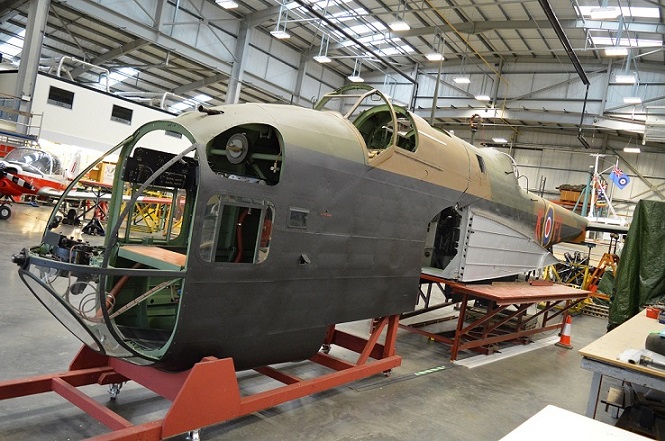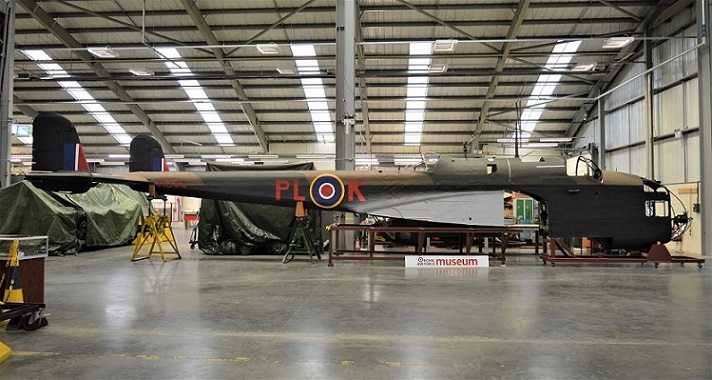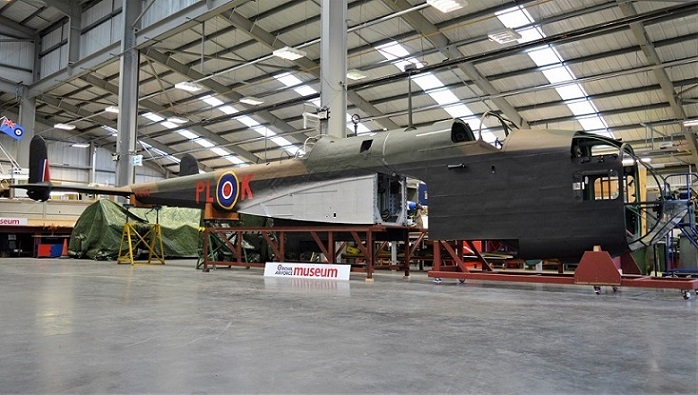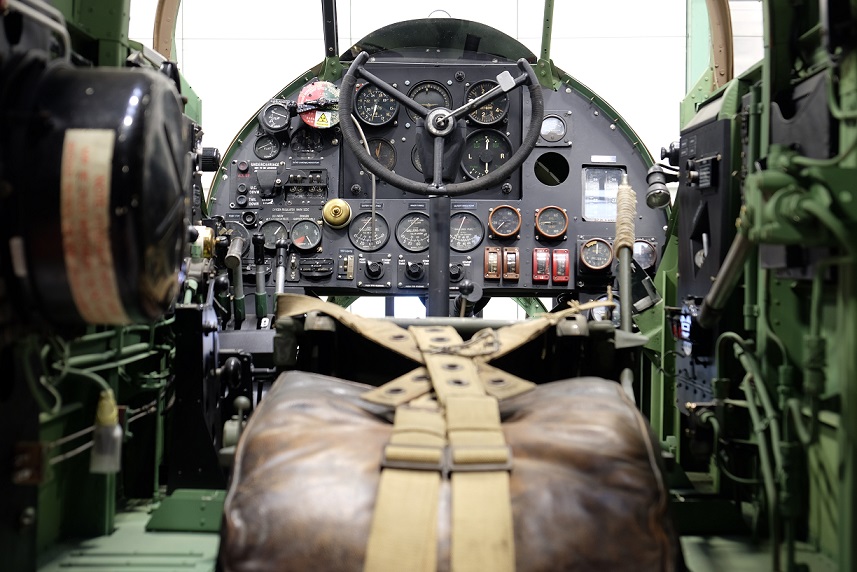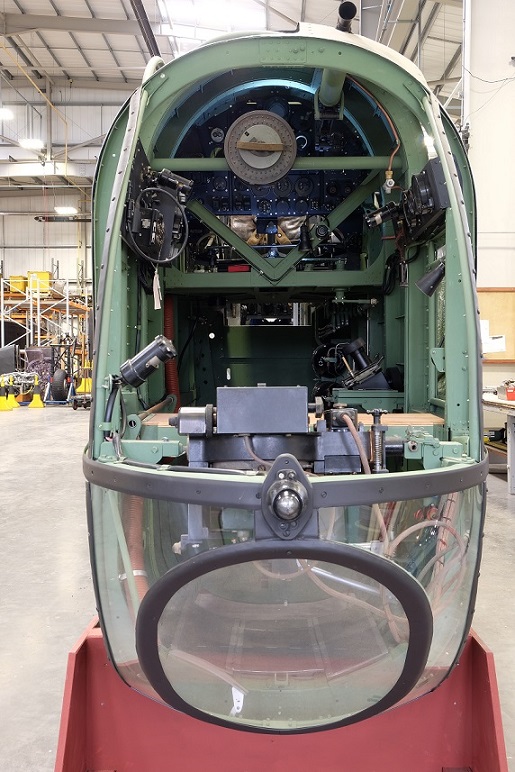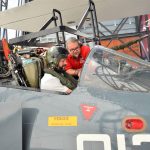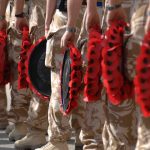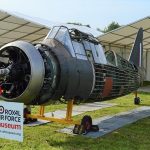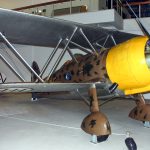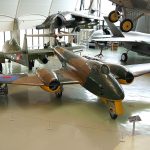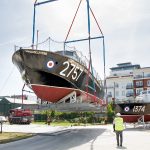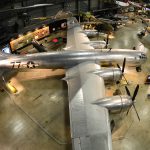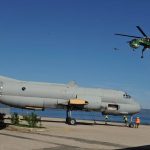*Handley Page Hampden TB Mk.I P1344, under restoration for the past decade or so at Royal Air Force Museum Cosford, is making huge steps towards becoming a complete aircraft again. As one of the Museum’s longest-running conservation projects, the aircraft has undergone a major transformation; for the first time since the mid-1940s you can see a complete fuselage for a Hampden in the UK. And it won’t be long before aviation fans can catch another glimpse of the Hampden. She goes on show during the Museum’s Conservation Center Open Week taking place from November 12th through the 18th.
All four of the aircraft’s primary fuselage sections are now fully assembled and re-attached. Museum conservators have repainted the Hampden with her original 144 Squadron color scheme and serial number. It’s been a labor of love for the Museum’s skilled Aircraft Technicians. While the airframe is substantially original, some components have had to be rebuilt from scratch using measurements taken from badly damaged surviving parts and original Handley Page pre-production drawings dating from the late 1930s.
The Museum’s Hampden, serial number P1344, is one of only three substantive examples of the type remaining. Her last flight took place during the night of September 4/5, 1942. She was part of a flight of 32 Hampdens which took off from RAF Sumburgh in the Shetland Islands heading to northern Russia to provide protection for the Arctic Convoys supplying the Allied war effort on the Eastern Front. Eight other Hampdens failed to survive that flight; a costly night in terms of both human and aircraft losses. Three of the five men aboard P1344 died when the aircraft was shot down, with the two survivors becoming prisoners of war. P1344’s wreckage lay on the Kola Peninsula, in northern Russia for the next half century. With the fall of the Berlin Wall in 1989, a spate of recoveries of WWII aircraft took place across the former Soviet Bloc countries, and Russia was no different. A recovery team salvaged the Hampden’s remains during 1989. Jeet Mahal imported P1344 into the UK during 1991, with the RAF Museum eventually acquiring the her in August, 1992. Her airframe was considerably battered, and missing substantial components, especially from the right wing, so it took a few years before the RAF Museum decided how to go about her restoration/preservation. But now the British twin-engined medium bomber is being lovingly brought back to life, and she should be complete once again sometime in the next decade.
Since members of the public last had the opportunity to view P1344 roughly a year ago, the restoration of her badly damaged airframe has advanced considerably, with the unmistakable shape of the Hampden’s silhouette now being clearly evident. While much of the original airframe material has been successfully incorporated into the project, the tail boom was structurally too badly damaged to re-use, so museum technicians built a new one for the project. Within the last few weeks, the Museum’s Surface Finish Technician has repainted this newly constructed section, which is now also re-attached to the original rear fuselage (which still bears bullet hole scars from the night of the aircraft’s fatal shoot-down on September 4th, 1942. Adding the tail-plane, which is 30-40% original, and the newly constructed forward fuselage, the RAF Museum Cosford aircraft is one of only two substantially intact-looking Hampden’s worldwide, with the other, P5436, on display at the Canadian Museum of Flight, near Vancouver, British Columbia. The Lincolnshire Aviation Heritage Center in East Kirkby, England, is also working on the restoration of Hampden TB Mk.I AE436.
Date: 12-18 November 2018
Time: 10.15am-1.00pm
Cost: £5.00 per person
RAF Museum Conservation Center Manager, Darren Priday said: “We’re delighted with how the Hampden, a lesser known aircraft of the RAF inventory, is finally coming together after all these years. We are currently trying to source an original rear undercarriage and tail wheel, but if one can’t be found it will be replicated and made in the Centre. The aircraft has been populated internally with items from the Museum’s reserve collection and the next twelve months will see work commence on manufacturing flying control wires to enable the elevator and rudder to move as well as fabricating new bomb bay doors.
Hampden’s, along with Wellington’s, which we also have here at the Center, bared the brunt of the early bombing campaign over Europe. They played a vital role in the RAF and our nation’s history and I’m confident this rare example will be warmly received by visitors at our Open Week next month.” Aviation fans will be able to view the newly painted fuselage from 12-18 November when the Michael Beetham Conservation Centre opens its doors to visitors, giving behind the scenes access to aircraft conservation projects and the chance to speak with the team that makes them happen.
Other projects on view will include Westland Lysander Mk.III R9215, Vickers Wellington Mk.X MF628, Range Safety Launch, sole surviving Dornier Do 17 wk.nr.1160 and an original German LVG C.VI reconnaissance biplane dating from WWI. Museum Technicians, Apprentices and Volunteers will be available throughout the week to speak with visitors about their work and answer any questions they may have. The Conservation Center will be open to the public from 10.15am to 1.00pm each day between November 12th through the 18th. Admission is £5.00 per person (children under 16 are free, but must be accompanied by an adult). The Museum’s other hangars will be open from 10am until 4pm every day, with entry to the main Museum being free of charge. For further information, please visit the RAF Museum’s website www.rafmuseum.org/cosford.
Visitors attending the Open Week on Saturday November 17th may also be interested in attending a lecture entitled The Glider Pilot Regiment and the RAF which will take place at 2.00pm in the Museum’s Conference Room located in the Visitor Centre. Chaired by the Glider Pilot Regiment Society Chairperson, Jane Barkway-Harney, the presentation will discuss the Regiment’s genesis, the selection and training of its volunteers, and the role that the RAF played in preparing these Army soldiers to take to the skies. The talk will also focus on the 75th Anniversary of the Invasion of Sicily, the longest military glider tow in history, and Operation Varsity – the largest single Airborne lift and final operation of the Glider Pilot Regiment during Second World War. This operation saw RAF crews seconded to the Glider Pilot Regiment as glider pilots to make up for previous losses. The talk will last approximately 1hr 15 minutes and costs £5 per person. Further details can be found on the Museum’s website.
*This article is adapted from an RAF Museum press release







